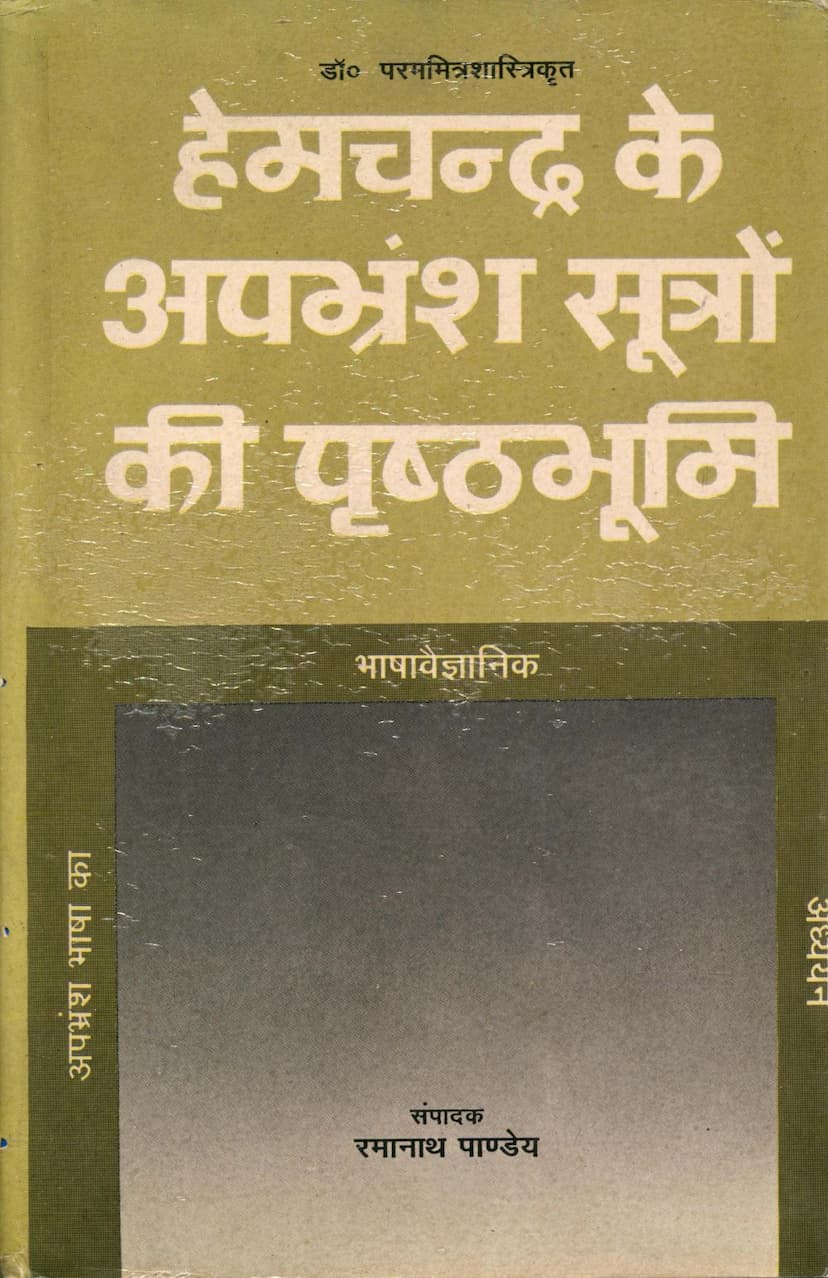Hemchandra Ke Apbhramsa Sutro Ki Prushthabhumi
Added to library: September 1, 2025

Summary
This book, "Hemchandra Ke Apbhramsa Sutro Ki Prushthabhumi" (The Background of Hemachandra's Apabhramsa Sutras) by Dr. Parammitra Shastri and edited by Dr. Ramanath Pandey, is a comprehensive linguistic study of the Apabhramsa language, focusing on the grammatical framework provided by the renowned Jain scholar Acharya Hemachandra.
Here's a summary of its key aspects based on the provided text:
Core Objective and Significance:
- The book aims to fill a perceived gap in Hindi literature by providing a thorough and purely linguistic study of Apabhramsa and its grammar.
- It emphasizes the crucial role of Apabhramsa in the evolution of modern Indian languages, particularly Hindi, demonstrating its contribution to language development and showing how modern Hindi evolved from Apabhramsa grammar.
- It positions Apabhramsa as the foundational source of all modern Indo-Aryan languages, highlighting its deep connection with Hindi, making its study essential for a proper understanding of Hindi language and grammar.
Focus on Hemachandra's Apabhramsa Sutras:
- The study centers on Hemachandra's seminal work on Apabhramsa, which comprises 120 sutras (aphorisms) dedicated to the language.
- It notes that besides these dedicated sutras, Hemachandra also included elements related to Apabhramsa in the "Dhatvadesha" (verbal affixes) of the second pada of his Prakrit chapter, considering them cooperative forms of Apabhramsa.
- The text contrasts Hemachandra's detailed treatment of Apabhramsa (120 sutras) with other Prakrit grammarians, who wrote less extensively on it, with the exception of Markandeya. Hemachandra's grammatical knowledge of Apabhramsa is considered the most comprehensive.
- Specifically, Hemachandra presented Apabhramsa grammar within the eighth chapter of his Prakrit grammar, dedicating sutras 329 to 448 to it. The last two sutras are stated to be on general Prakrit, leaving the remaining 118 sutras for developing various grammatical aspects of Apabhramsa.
Apabhramsa as a Linguistic Stage:
- The book places Apabhramsa within the historical development of Indo-Aryan languages, dividing the period into Pali, Prakrit, and Apabhramsa epochs.
- Apabhramsa is identified as the final stage of Middle Indo-Aryan, considered the root source of modern Indo-Aryan languages.
- Apabhramsa is stated to have been the language of the common people for approximately 500-600 years, from around 500 CE to 1000 CE.
- The text discusses the term "Apashabda" (corrupted word) in relation to Apabhramsa, explaining that it refers to words not conforming to Sanskrit grammar.
- It touches upon the different views of Sanskrit grammarians (like Patanjali) who considered all Prakrit languages as falling under Apabhramsa, versus Prakrit grammarians who saw Apabhramsa as a subordinate variety of Prakrit.
- The book acknowledges the 27 types of Apabhramsa mentioned in "Prakrit Chandrika."
Key Features and Analysis:
- Linguistic Analysis: Dr. Parammitra Shastri provides a detailed and scientific analysis of Apabhramsa, demonstrating its role as the origin of modern Indian languages.
- Historical Context: The book explores the historical period of Apabhramsa (roughly 500-1000 CE), considering it a transitional phase in Indian history, and discusses the cultural significance and evolution of the language.
- Influence and Expression: It highlights how Apabhramsa was the medium for expressing the sentiments of lower and middle classes, and was adopted by Siddhas of the Buddhist sect, Jains, and Shaivites. It also notes its use in expressing love.
- Hemachandra's Apabhramsa: The study posits that Hemachandra's Apabhramsa represents Shauraseni Apabhramsa and was widely accepted in its time, similar to modern Hindi. It serves as a connecting link between Old and Modern Indian languages.
- Compilation and Synthesis: The author has attempted to coordinate various sub-dialects of Apabhramsa within Hemachandra's grammar, noting that Hemachandra himself did not explicitly mention distinct Apabhramsa dialects like later writers such as Markandeya did.
- Comparison with other Prakrit Grammarians: The book analyzes and evaluates the contributions of other Prakrit grammarians to Apabhramsa studies.
- Detailed Grammatical Breakdown: The table of contents reveals a comprehensive treatment of Apabhramsa grammar, including chapters on phonology (sound changes), morphology (word formation), syntax (sentence structure), indeclinables, verbal forms, nominals, nominal derivations (taddhita and kṛt), and sentence construction.
- Word-Study: The appendix includes a glossary of words cited in Hemachandra's Apabhramsa sutras, providing their Hindi meanings.
Scholarly Context and Influences:
- The book acknowledges the work of previous scholars like Dr. Herman Jacobi, Dr. P. D. Gune, Muni Jinavijaya, Pt. Nathuram Premi, Dr. Hazariprasad Dwivedi, Pt. Rahul Sankrityayan, and Dr. Baburam Saxena in the field of Apabhramsa literature and linguistics.
- It also references works of Western scholars like Dr. Pischel, Grierson, and L. de La Vallée Poussin.
- The editor, Dr. Ramanath Pandey, expresses gratitude to his father and his father-in-law (Dr. Parammitra Shastri), as well as his academic mentors like Prof. Brajmohan Chaturvedi and Prof. Mahendra Prasad Singh.
In essence, "Hemchandra Ke Apbhramsa Sutro Ki Prushthabhumi" is presented as a landmark work in Hindi for its rigorous, independent, and scientific research into Hemachandra's Apabhramsa sutras, aiming to illuminate the foundational role of Apabhramsa in the development of Indian languages, particularly Hindi.